For our tour description, itinerary,
past triplists, dates, fees, and more, please VISIT OUR TOUR PAGE.
See this triplist in printable PDF format with media only on
page 1.

Though covered with
scaffolding, the Parthenon and the hulking mass of the
Acropolis still impresses. (Photo by guide Megan Crewe)
Early May is a wonderful time to explore the timeless
landscapes of rural Greece. With a combination of gorgeous
scenery, patterned tapestries of wildflowers, and an
ever-changing mix of birds, the countryside offers plenty to
enjoy. Add in a handful of cultural attractions -- ancient
temples, 1000-year old mosaics, a world class museum or two --
and a congenial group of traveling companions, and you get a
fine mix of memories. This year, we had a rather toasty time
throughout, with temperatures in the mid 80s and lots of
sunshine; our only significant rain coming high on Mount
Parnassos, making our search for higher altitude birds a
rather soggy affair! The fine, settled weather meant we had
surprisingly few migrants (other than the myriad shorebirds,
that is), presumably because they just kept flying. But there
were lots of highlights regardless.
Great Crested Grebes performed their charming "mirror
dances". Masked Shrikes gathered nesting material and hunted
for tasty morsels around our picnic spot at Doriskos.
Slender-billed Gulls paddled around a seaside pond, looking
down their long noses. A Rueppell's Warbler flicked through a
flowering bush, so close we could almost reach out and touch
him. European Rollers flashed turquoise wings as they chased
after flying prey. A hammer-headed Eurasian Hoopoe chanted
from a tall tree. Screaming clouds of Common and Pallid swifts
swirled over tight-packed rooftops. Little Bitterns skulked
along the edges of dense reedbeds. A Eurasian Wren chortled
from a felled tree trunk, his tail cocked over his head.
Technicolor European Bee-eaters swarmed over pond edges and
causeways, or sat like beads on a string along utility wires.
A pair of Sardinian Warblers bounced through the grass near
the entrance to the Acropolis, ferrying hurried mouthfuls to
two chirping youngsters. A Black Woodpecker made several noisy
passes before swooping in to land on a dead tree trunk. A male
Stonechat serenaded from a tiny evergreen.
White Storks stalked roadside fields or stood tall on huge
stick nests (and one even demonstrated its head-back,
bill-clacking courtship display). A pair of Egyptian Vultures
glided overhead, strikingly white against a blue, blue sky. A
sand-colored Isabelline Wheatear flicked across a rough plowed
patch. Spotted Redshanks, sporting their striking breeding
plumage, huddled in a wind-whipped pond. A Blue Rock-Thrush
ferried mouthfuls of food to youngsters tucked into a crevice
on the Treasury of Athens building at Delphi. But of course,
it wasn't just the birds that drew our attention on this tour.
We spent a morning in the fantastic new Parthenon museum, with
Irini to point out some of the special treasures, then
wandered among buildings that dated back more than two
millenia.
Thanks so much for joining me for some spring adventures in
this lovely country. I hope to see all of you again,
somewhere, someday!
-- Megan
For more information about this tour, including future
departures, visit our website at www.fieldguides.com.
And to see this same triplist online, go to http://www.fieldguides.com/triplists/gre12LIST.pdf
and you will find the list in its entirety.
KEYS FOR THIS LIST
One of the following keys may be shown in brackets for
individual species as appropriate: * = heard only, I =
introduced, E = endemic, N = nesting, a = austral migrant, b =
boreal migrant
Anatidae (Ducks, Geese, and Waterfowl)
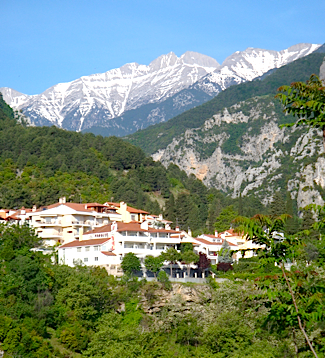
The touristy
village of Litochoro nestles at the base of Mount Olympus.
(Photo by guide Megan Crewe)
GRAYLAG GOOSE (Anser anser)
MUTE SWAN (Cygnus olor)
COMMON SHELDUCK
(Tadorna tadorna)
MALLARD (Anas platyrhynchos)
GARGANEY (Anas querquedula)
COMMON POCHARD
(Aythya ferina)
FERRUGINOUS DUCK
(Aythya nyroca)
Podicipedidae (Grebes)
LITTLE GREBE (Tachybaptus ruficollis)
GREAT CRESTED
GREBE (Podiceps cristatus)
[N]
EARED GREBE
(Podiceps nigricollis)
Phoenicopteridae (Flamingos)
GREATER FLAMINGO (Phoenicopterus roseus)
Procellariidae (Shearwaters and Petrels)
LEVANTINE SHEARWATER (Puffinus yelkouan)
Ciconiidae (Storks)
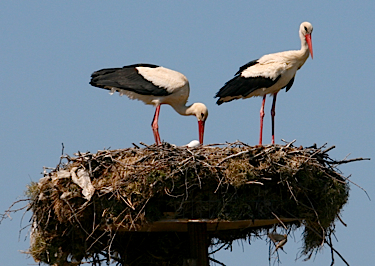
Greece is home to
a staggering number of White Storks, which nest on utility
poles (and specially constructed platforms) all across the
northern part of the country. The untidy stork nests are
also home to dozens of Spanish Sparrows and House
Sparrows, which build their "condos" into the base of the
stick piles. (Photo by guide Megan Crewe)
BLACK STORK (Ciconia nigra)
WHITE STORK
(Ciconia ciconia)
[N]
Phalacrocoracidae (Cormorants and Shags)
GREAT CORMORANT (Phalacrocorax carbo)
EUROPEAN SHAG
(Phalacrocorax aristotelis)
PYGMY CORMORANT
(Phalacrocorax pygmaeus)
Pelecanidae (Pelicans)
GREAT WHITE PELICAN (Pelecanus onocrotalus)
DALMATIAN PELICAN
(Pelecanus crispus)
Ardeidae (Herons, Egrets, and Bitterns)
LITTLE BITTERN (Ixobrychus minutus)
GRAY HERON
(Ardea cinerea)
PURPLE HERON
(Ardea purpurea)
GREAT EGRET
(Ardea alba)
LITTLE EGRET
(Egretta garzetta)
SQUACCO HERON
(Ardeola ralloides)
BLACK-CROWNED
NIGHT-HERON (Nycticorax
nycticorax)
Threskiornithidae (Ibises and Spoonbills)
GLOSSY IBIS (Plegadis falcinellus)
EURASIAN SPOONBILL
(Platalea leucorodia)
Accipitridae (Hawks, Eagles, and Kites)
EUROPEAN HONEY-BUZZARD (Pernis apivorus)
BLACK KITE
(Milvus migrans)
WHITE-TAILED EAGLE
(Haliaeetus albicilla) [N]
EGYPTIAN VULTURE
(Neophron percnopterus)
EURASIAN GRIFFON
(Gyps fulvus)
CINEREOUS VULTURE
(Aegypius monachus)
SHORT-TOED EAGLE
(Circaetus gallicus)
EURASIAN
MARSH-HARRIER (Circus
aeruginosus)
LEVANT SPARROWHAWK
(Accipiter brevipes)
EURASIAN
SPARROWHAWK (Accipiter nisus)
COMMON BUZZARD
(Buteo buteo)
LESSER SPOTTED
EAGLE (Aquila pomarina)
Falconidae (Falcons and Caracaras)
LESSER KESTREL (Falco naumanni)
EURASIAN KESTREL
(Falco tinnunculus)
RED-FOOTED FALCON
(Falco vespertinus)
EURASIAN HOBBY
(Falco subbuteo)
PEREGRINE FALCON
(Falco peregrinus)
Rallidae (Rails, Gallinules, and Coots)
EURASIAN MOORHEN (Gallinula chloropus)
EURASIAN COOT
(Fulica atra)
Burhinidae (Thick-knees)
EURASIAN THICK-KNEE (Burhinus oedicnemus)
Charadriidae (Plovers and Lapwings)

Fields of blood
red Common Poppies stretched along roadsides all across
Greece, signs that some farmers are still using "the old
ways" rather than spraying their crops with heavy
herbicides. (Photo by guide Megan Crewe)
SPUR-WINGED PLOVER (Vanellus spinosus) [N]
BLACK-BELLIED
PLOVER (Pluvialis squatarola)
KENTISH PLOVER
(KENTISH) (Charadrius
alexandrinus alexandrinus)
COMMON RINGED
PLOVER (Charadrius hiaticula)
LITTLE RINGED
PLOVER (Charadrius dubius)
Haematopodidae (Oystercatchers)
EURASIAN OYSTERCATCHER (Haematopus ostralegus)
Recurvirostridae (Stilts and Avocets)
BLACK-WINGED STILT (Himantopus himantopus)
PIED AVOCET
(Recurvirostra avosetta)
Scolopacidae (Sandpipers and Allies)
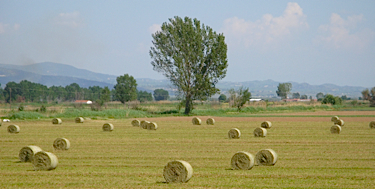
A rural scene
near Lake Kerkini. (Photo by guide Megan Crewe)
COMMON SANDPIPER (Actitis hypoleucos)
SPOTTED REDSHANK
(Tringa erythropus)
COMMON GREENSHANK
(Tringa nebularia)
WOOD SANDPIPER
(Tringa glareola)
COMMON REDSHANK
(Tringa totanus)
BLACK-TAILED
GODWIT (Limosa limosa)
RUDDY TURNSTONE
(Arenaria interpres)
LITTLE STINT
(Calidris minuta)
DUNLIN (Calidris alpina)
CURLEW SANDPIPER
(Calidris ferruginea)
RUFF (Philomachus pugnax)
Glareolidae (Pratincoles and Coursers)
COLLARED PRATINCOLE (Glareola pratincola)
Laridae (Gulls, Terns, and Skimmers)
SLENDER-BILLED GULL (Chroicocephalus genei)
BLACK-HEADED GULL
(Chroicocephalus ridibundus)
MEDITERRANEAN GULL
(Ichthyaetus melanocephalus)
YELLOW-LEGGED GULL
(Larus michahellis michahellis)
LITTLE TERN
(Sternula albifrons)
GULL-BILLED TERN
(Gelochelidon nilotica)
BLACK TERN
(Chlidonias niger)
WHITE-WINGED TERN
(Chlidonias leucopterus)
WHISKERED TERN
(Chlidonias hybrida)
COMMON TERN
(Sterna hirundo)
Columbidae (Pigeons and Doves)
ROCK PIGEON (Columba livia)
COMMON WOOD-PIGEON
(Columba palumbus)
EUROPEAN
TURTLE-DOVE (Streptopelia
turtur)
EURASIAN
COLLARED-DOVE (Streptopelia
decaocto) [N]
Cuculidae (Cuckoos)
COMMON CUCKOO (Cuculus canorus)
Strigidae (Owls)
LITTLE OWL (Athene
noctua)
Apodidae (Swifts)
ALPINE SWIFT (Apus melba)
COMMON SWIFT
(Apus apus)
PALLID SWIFT
(Apus pallidus)
Meropidae (Bee-eaters)
EUROPEAN BEE-EATER (Merops apiaster)
Coraciidae (Rollers)
EUROPEAN ROLLER (Coracias garrulus)
Upupidae (Hoopoes)
EURASIAN HOOPOE (Upupa epops)
Picidae (Woodpeckers)
EURASIAN WRYNECK (Jynx torquilla)
SYRIAN WOODPECKER
(Dendrocopos syriacus)
BLACK WOODPECKER
(Dryocopus martius)
GREEN WOODPECKER
(Picus viridis)
Laniidae (Shrikes)
RED-BACKED SHRIKE (Lanius collurio)
LESSER GRAY SHRIKE
(Lanius minor)
MASKED SHRIKE
(Lanius nubicus)
WOODCHAT SHRIKE
(Lanius senator)
Oriolidae (Old World Orioles)
EURASIAN GOLDEN ORIOLE (Oriolus oriolus)
Corvidae (Crows, Jays, and Magpies)
EURASIAN JAY (Garrulus glandarius)
EURASIAN MAGPIE
(Pica pica)
YELLOW-BILLED
CHOUGH (Pyrrhocorax graculus)
EURASIAN JACKDAW
(Corvus monedula)
HOODED CROW
(Corvus cornix)
COMMON RAVEN
(Corvus corax)
Alaudidae (Larks)
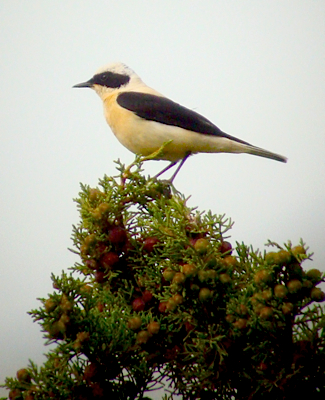
A trio of
wheatears are possible on the Greece tour. This was the
most widespread species: the Black-eared Wheatear. It
comes in two color morphs; this is the pale throated form.
(Photo by guide Megan Crewe)
CALANDRA LARK (Melanocorypha calandra)
GREATER SHORT-TOED
LARK (Calandrella
brachydactyla)
CRESTED LARK
(Galerida cristata)
SKY LARK (Alauda arvensis)
WOOD LARK (Lullula arborea)
Hirundinidae (Swallows)
BANK SWALLOW (Riparia riparia)
EURASIAN
CRAG-MARTIN (Ptyonoprogne
rupestris)
BARN SWALLOW
(Hirundo rustica) [N]
RED-RUMPED SWALLOW
(Cecropis daurica)
COMMON
HOUSE-MARTIN (Delichon
urbicum) [N]
Paridae (Chickadees and Tits)
SOMBRE TIT (Poecile
lugubris)
MARSH TIT (Poecile palustris)
COAL TIT (Periparus ater) [N]
CRESTED TIT
(Lophophanes cristatus)
GREAT TIT (Parus major)
EURASIAN BLUE TIT
(Cyanistes caeruleus) [N]
Remizidae (Penduline-Tits)
EURASIAN PENDULINE-TIT (Remiz pendulinus)
Aegithalidae (Long-tailed Tits)
LONG-TAILED TIT (Aegithalos caudatus)
[*]
Sittidae (Nuthatches)
EURASIAN NUTHATCH (Sitta europaea)
ROCK NUTHATCH
(Sitta neumayer)
Certhiidae (Treecreepers)
SHORT-TOED TREECREEPER (Certhia brachydactyla)
Troglodytidae (Wrens)
EURASIAN WREN (Troglodytes troglodytes)
Regulidae (Kinglets)
FIRECREST (Regulus
ignicapilla)
Cettiidae (Bush-Warblers and Allies)
CETTI'S WARBLER (Cettia cetti)
Phylloscopidae (Leaf-Warblers)
WILLOW WARBLER (Phylloscopus trochilus)
COMMON CHIFFCHAFF
(Phylloscopus collybita)
Acrocephalidae (Reed-Warblers and Allies)
EASTERN OLIVACEOUS WARBLER (Hippolais pallida)
SEDGE WARBLER
(Acrocephalus schoenobaenus)
GREAT REED-WARBLER
(Acrocephalus arundinaceus)
Sylviidae (Old World Warblers)
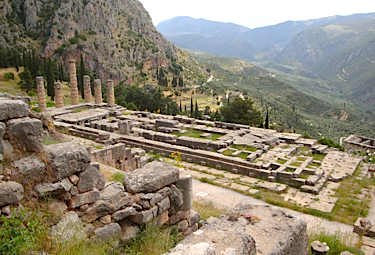
Delphi's ruins
sprawl for hundreds of meters down the mountainside. In
the foreground is the foundation of the temple of Apollo
and Dionysius. This was where Delphi's famous oracle made
her proclamations. (Photo by guide Megan Crewe)
BLACKCAP (Sylvia
atricapilla)
EASTERN ORPHEAN
WARBLER (Sylvia crassirostris)
GREATER
WHITETHROAT (Sylvia communis)
RUEPPELL'S WARBLER
(Sylvia rueppelli)
SUBALPINE WARBLER
(Sylvia cantillans)
SARDINIAN WARBLER
(Sylvia melanocephala)
Muscicapidae (Old World Flycatchers)
SPOTTED FLYCATCHER (Muscicapa striata)
EUROPEAN ROBIN
(Erithacus rubecula)
COMMON NIGHTINGALE
(Luscinia megarhynchos)
BLACK REDSTART
(Phoenicurus ochruros)
BLUE ROCK-THRUSH
(Monticola solitarius) [N]
WHINCHAT (Saxicola rubetra)
STONECHAT
(EUROPEAN) (Saxicola torquatus
rubicola)
NORTHERN WHEATEAR
(Oenanthe oenanthe)
BLACK-EARED
WHEATEAR (Oenanthe hispanica)
ISABELLINE
WHEATEAR (Oenanthe isabellina)
Turdidae (Thrushes and Allies)
EURASIAN BLACKBIRD (Turdus merula)
MISTLE THRUSH
(Turdus viscivorus)
Sturnidae (Starlings)
EUROPEAN STARLING (Sturnus vulgaris)
Motacillidae (Wagtails and Pipits)
WESTERN YELLOW WAGTAIL (BLACK-HEADED)
(Motacilla flava feldegg)
GRAY WAGTAIL
(Motacilla cinerea)
WHITE WAGTAIL
(WHITE-FACED) (Motacilla alba
alba)
TAWNY PIPIT
(Anthus campestris)
Emberizidae (Buntings, Sparrows and
Allies)
CIRL BUNTING (Emberiza cirlus)
CRETZSCHMAR'S
BUNTING (Emberiza caesia)
BLACK-HEADED
BUNTING (Emberiza
melanocephala)
CORN BUNTING
(Emberiza calandra)
Fringillidae (Siskins, Crossbills, and
Allies)
COMMON CHAFFINCH (Fringilla coelebs)
EUROPEAN
GREENFINCH (Chloris chloris)
EUROPEAN GOLDFINCH
(Carduelis carduelis)
EURASIAN LINNET
(Carduelis cannabina)
EUROPEAN SERIN
(Serinus serinus)
HAWFINCH (Coccothraustes coccothraustes)
Passeridae (Old World Sparrows)
HOUSE SPARROW (Passer domesticus) [N]
SPANISH SPARROW
(Passer hispaniolensis) [N]
EURASIAN TREE
SPARROW (Passer montanus)
EUROPEAN RED
SQUIRREL (Sciurus vulgaris)
RED FOX (Vulpes vulpes)
BLACK-BACKED
JACKAL (Canis mesomelas)
Herps we found during the trip (thanks for the IDs, Jim!)
European Pond Turtle (Emys orbicularis) - We spotted one
hauled out on the side of an concrete irrigation ditch on the
Evros delta.
Balkan Pond Turtle (Mauremys rivulata) - One at the concrete
stream crossing near Dadia.
Spur-thighed (Greek) Tortoise (Testudo graeca) -
Hermann's Tortoise (Testudo hermanni) - One at Iasmos gorge
wasn't too excited about being closely examined -- and let Jim
know by peeing all over his gloves.
European Green Toad (Bufo viridis) - One under a board near
Fanari, seen as we walked out to check the pratincole colony.
Balkan (Greek Marsh) Frog (Pelophylax kurtmuelleri) - One in
the water trough at the Doriskos picnic area was definitely a
bit the worse for wear.
Greek (Balkan) Stream Frog (Rana graeca) - One sat on a
streamside rock below the monastery on Mount Olympus.
European Green Lizard (Lacerta viridis) - Pete spotted one
outside the viewing blind at the Dadia Raptor Center.
Erhard's Wall Lizard (Podarcis erhardii) - These little brown
lizards were quite common on Mount Olympus.
Worm Snake (Typhlops vermicularis) - One of these tiny blind
snakes was squashed along the roadside near our Delphi hotel;
how it got there was a mystery, since this species normally
spends its life underground!
Dice Snake (Natrix tessellata) - A dead one near the water
trough at Doriskos had us wondering whether it was the water
or the holiday crowds that caused the "carnage" there!
Totals for the tour: 170 bird taxa and 3 mammal taxa







